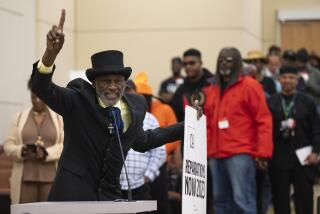Reaching Into Deep Pockets: There Must Be a Better Way
- Share via
Once again, accident law is producing sharp conflict in Sacramento. The problem arises from the traditional legal rule that an innocent victim who is hurt by the combined negligence of two defendants may recover the entire judgment from either one of them--even if a jury considers the two defendants not equally at fault. This is “joint and several liability,” a doctrine that courts have applied for centuries.
The “deep pockets” aspect comes into play when it turns out, as it often does, that the defendant more seriously at fault is either totally insolvent or has too little insurance to help pay a large judgment. As a result, the defendant who is less at fault--say, 20%--is forced to bear the entire burden.
Is this situation fair? On the one hand, it is surely better that the plaintiff get the compensation due from at least one of the negligent parties than it is for the victim to never recoup his lost wages, medical bills and other expenses. But, understandably, the less blameworthy defendant thinks it unfair to have to pay the share owed by the insolvent defendant. This argument gains power as the imbalance in proportions of fault increases. (If the plaintiff also bears some share of the blame for the accident, the moral arguments for plaintiff collapse.)
The issue has attained high visibility lately because attorneys have only recently begun to seriously pursue the potential of a municipality as a co-defendant. Cities are being held liable for a variety of accidents, most of them involving auto accidents in which the negligent (perhaps drunk) motorist runs a stop sign or traffic light, but in which a jury also finds that the city bears some blame for having a dangerous intersection.
Liability-insurance premiums for cities have risen as much as several hundred percent, and have been accompanied by sharply reduced coverage. Cities, however, are not the only ones jolted by the “deep pockets” concept. Other large defendants, such as utilities and hospitals, are doubtless saying “welcome to the club. It’s nice to be joined by folks with political clout.”
The major legislative proposal to change the situation has been a bill by state Sen. John F. Foran (D-San Francisco), a version of which will go before voters in June as an initiative. Under this measure, all defendants (not just a city) would remain jointly and severally liable for all economic damages--bills, lost wages, property damage--but would be liable for pain and suffering only in proportion to their fault. Thus, a solvent defendant found 20% at fault would be exposed to liability for all the plaintiff’s economic loss but for only 20% of the award for pain and suffering. The implication of both the bill and the initiative is that pain and suffering, since it is not economic in nature, is less deserving of “full compensation” when balanced against the defendants’ fairness argument.
Even if this approach were sound, it fails to recognize that plaintiffs’ attorneys in accident cases work on a contingency fee--and pain-and-suffering damages provide the main source for that fee, permitting the victim to retain all or most of the economic damages. Legislation that protects an innocent victim’s recovery of only economic items must also consider the hidden economic item of legal fees.
But is the bill basically sound?
From time to time state legislatures respond to strong political pressures to shore up some part of the accident compensation system that appears to have fallen into disrepair. But sporadic legislative attention to isolated trouble spots without consideration of the whole structure simply produces an array of uncoordinated statutes that treat similarly situated plaintiffs differently for no apparent reason.
In the medical-malpractice area, for example, the California Legislature, responding to pressures in the mid-1970s, decreed that no plaintiff may recover more than $250,000 for pain and suffering. Why not apply that same rule to all personal-injury plaintiffs? That would at least treat equally all claimants who suffer comparable injuries, and more clearly satisfy a community’s sense of fairness.
Even more broadly, we must recognize that the pressure to find and reach “deep pockets” comes from the overwhelming sense among judges and jurors--and the community at large--that all innocent victims of accidents should be compensated. Since current law makes negligence the usual requisite for recovery, jurors are encouraged to search hard to find at least a little negligence (or to make some up). The jury responds readily, especially when it suspects that liability insurance is present.
The time has come to think seriously about developing a system of compensation that does not require crowded court calendars, long delays in getting compensation to victims, use and abuse of jurors to make the system do its “dirty work,” transfer of one-third of all damage awards and settlements to lawyers as fees, instability of insurance markets and occasional bankrupting of defendants. Since society’s goal is clearly one of compensating all innocent victims of accidents, the Legislature should forthrightly explore broadly based programs to achieve that result.
More to Read
Sign up for Essential California
The most important California stories and recommendations in your inbox every morning.
You may occasionally receive promotional content from the Los Angeles Times.













